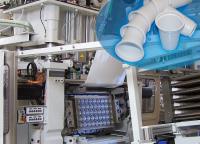plasticker-News
| 2009-04-20 |

|
ILLIG: New Generation of automatic pressure forming machines
|
ILLIG (www.illig.de), manufacturer of thermoforming machines, have now completed their 3rd Generation of automatic pressure forming machines with the new RDM 75K (Photo). These machines are suitable for the production of formed parts for a multitude of applications, with the main emphasis on cups of all shapes and sizes in large quantities. There is now a fourth size in the RDM-K group, a group already established and well accepted on the market. The RDM 75K features a forming area of 735 mm x 465 mm and idle speeds of up to 42 cycles/minute. Compared to its predecessor, it is possible to constantly achieve increases in cycle speed of at least 30 percent, subject to material and cup shape sometimes even more. Other innovations with this machine and tooling are uniformity and accurate reproducibility of all cup shapes which, until now, has been unachievable in thermoforming with multi-cavity tools. There is an approximate 10 % weight saving and thus material saving without any loss of cup rigidity. The stacking device has also been further developed to ensure the safe handling of the increased output from the thermoformer. Even cup shapes which are difficult to stack together are transferred automatically and reliably to the downstream equipment for further processing, eg. to pack the counted cup stacks into transport units or, for in-line production, to direct filling, sealing and packing operations. Value added increased by numerous innovations A major development found in 3rd Generation RDM-K automatic pressure forming machines is to reduce the use of forming air by up to 50 percent compared to the previous generation of machines which results in a considerable increase in dynamics during the build-up of forming air. Considerably faster forming with better definition in the individual cavities is a significant technological benefit. The forming air supply is now controlled simultaneously by individual valves on each cavity and thus controlled uniformly in a reproducible way from cycle to cycle. Identical conditions are provided for all cavities in a multi-cavity tool – all formed cups are therefore identical, of the same definition, weight and dimension. In this way dimensional tolerances previously specified eg. for the sealing rim thickness of yoghurt cups in the tenths of a millimeter range can be reduced significantly. Fluctuation of the sealing rim thickness is now in the range of some tenths of a micron. This also applies to the other dimensions too. A further influential innovation is the pressure level control of the downholders adjusted to the respective phase in the thermoforming process. In this way bead formation, previously unavoidable, on the upper cup rim is prevented. The material accumulation of approx. 10 percent of the part weight is now drawn into the side wall during stretching. This allows either the rigidity of the cup to be increased due to this "additional material" or the material thickness to be reduced. Lighter weight cups formed uniformly in every cavity contribute to a considerable increase in quality without loss of stability. The increase in productivity is augmented by an optimized new tool cooling system. Up to four cooling circuits are now available in the forming tool. They can be individually controlled and separately supply the upper and lower parts of the tool and the ejectors. Downholders are now directly cooled. The tools are equipped with cooling channels close to the cavities´ contours with cross sections dimensioned accordingly to ensure that the heat is dissipated from the cavities as quickly as possible during high cycle speeds. Lowering the cooling agent´s temperature is not required, quite the contrary. When in the past a cooling water temperature of 12 °C was required, tools for 3rd Generation RDM-K automatic pressure forming machines can now be cooled with water of 16 °C to 18 °C. A further important benefit of the increased temperature of the cooling water is the decreased risk of condensation forming on the tool with increasing atmospheric humidity. The new stacking device also contributes to improved part cooling. With this stacking device the cups need only now cool for one cycle before being positioned in the stacking cage. The high precision and accurate reproducibility of the 3rd Generation RDM-K automatic pressure forming machines also becomes obvious during production start-up. Once tools are heated to operating temperature, the output of the first cycle of formed cups is already ready to be stacked. The new RDM-K generation is suitable for both offline operation with supply from roll stock and also for in-line operation with pre-linked flat film extruder. Four sizes are available as standard, RDM 54K with a forming area of 520 x 300 mm², RDM 70K with 680 x 280, RDM 78K with 760 x 420 and now also RDM 75K with 735 x 465 mm² forming area. |
ILLIG Maschinenbau GmbH & Co. KG, Heilbronn, Germany
 back to news list back to news list |  back to top back to top |












